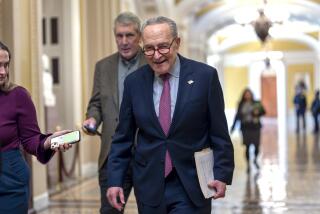Obama hails Senate stimulus deal
- Share via
President Obama welcomed the Senate compromise on a stimulus plan Saturday and exhorted Congress to hurry to finish work on the legislation that he had originally hoped to sign on his first day in office.
Despite Obama’s plea during his weekly radio address, the week ahead promises more haggling over the package. The Senate is expected to pass its version Tuesday, but then leaders must reconcile sharp differences with the House’s bill on a number of issues.
The Senate proposal protects millions of taxpayers from the bite of the alternative minimum tax while slashing the amount of aid to ailing states for education spending and school construction that the House included in its plan.
Lobbyists and lawmakers were gearing up for a fight this week on other remaining differences. That could make it difficult for House and Senate negotiators to meet Obama’s revised goal of having a measure in place for his signature by the Presidents’ Day break, which begins next weekend.
Obama sounded the theme of urgency Saturday. “Legislation of such magnitude deserves the scrutiny that it’s received over the last month, and it will receive more in the days to come,” he said. “The scale and scope of this plan is right. And the time for action is now.”
The president singled out the 16,000 estimated job gains that would result in Maine, whose two Republican senators, Susan Collins and Olympia J. Snowe, broke ranks to cut a compromise deal with Democrats.
Sen. Arlen Specter (R-Pa.) also pledged to support the bill, and Democrats hope to pick up a few other Republicans when the final vote comes.
The Senate convened a rare Saturday session to debate the compromise forged Friday.
Among the most difficult cuts for the White House and its liberal allies to accept was the elimination of $40 billion in aid to states, money that economists say is a relatively efficient way to pump up the economy by preventing layoffs, cuts in services or tax increases.
“It reduces a number of highly stimulative items like state fiscal relief . . . and largely substitute for it some large tax cuts that are highly ineffective as stimulus,” said Bob Greenstein, founder of the liberal Center on Budget and Policy Priorities. “So your net result is a bill that gets significantly less bang for the buck.”
For all the talk of cuts, the bill retains the core of Obama’s plan, designed to ease the worst economic recession in generations by combining hundreds of billions of dollars in spending to boost consumption by the public sector with tax cuts designed to increase consumer spending.
Negotiators left in the proposal $70 billion to address the alternative minimum tax to make sure families wouldn’t be socked with unexpected tax increases averaging $2,300 or so. The problem was going to be fixed later in the year anyway, and congressional economists say fixing it helps the economy surprisingly little.
Though publicly supportive of the bill, White House officials and top Democrats said they were disappointed that so much money was cut, including almost $20 billion for construction and repair of schools and university facilities. Those funds would have supported many construction jobs.
The $827-billion package debated Saturday in the Senate -- down from about $937 billion in a version debated during the week -- included Obama’s signature tax cut of up to $1,000 for working couples. Also included is a tax credit of up to $15,000 for home buyers and smaller breaks for people buying new cars.
Despite a growing sense of urgency, economists across the political spectrum continue to criticize the congressional stimulus plans.
Some say that the Senate alterations in the plan would undermine stimulus aims. Taxpayers who fall under the alternative minimum tax are generally well-off enough to be able to save some of the tax cuts they receive, delaying any positive effect on the economy. By comparison, school aid to states would probably be spent immediately to prevent layoffs of teachers.
Whatever its flaws, the stimulus package could create or save as many as 4 million jobs by the end of next year, helping to offset the 3.6 million jobs lost since the nation slid into recession in December 2007, according to an analysis by Allen Sinai, chief global economist for Decision Economics.
Many of those jobs will be created in state and local government, with fewer in private sectors such as education and health, he said.
As a result, Sinai said, the eventual recovery will be driven by government spending rather than tax cuts -- the first time that’s happened in the United States since President Reagan won election by vowing to get government off people’s backs.
In Hawaii on Friday, the chairwoman of the San Francisco Federal Reserve, Janet Yellen, added her voice as a supporter of quick action on a stimulus measure.
“In ordinary circumstances, there are good reasons why monetary, rather than fiscal, policy should be used to stabilize the economy,” she said, citing lags in adopting and implementing government spending programs. “The result is that fiscal stimulus sometimes kicks in only after the need has passed. However, the current situation is extraordinary, making the case for fiscal action very strong.”
Yellen said: “There is, and there should be, vigorous debate about the form it should take and about the likely effectiveness of particular fiscal strategies.
“However, it is critical that decisions on these matters be made on a timely basis so that the economy’s downward spiral is not allowed to deepen.”
More to Read
Sign up for Essential California
The most important California stories and recommendations in your inbox every morning.
You may occasionally receive promotional content from the Los Angeles Times.











